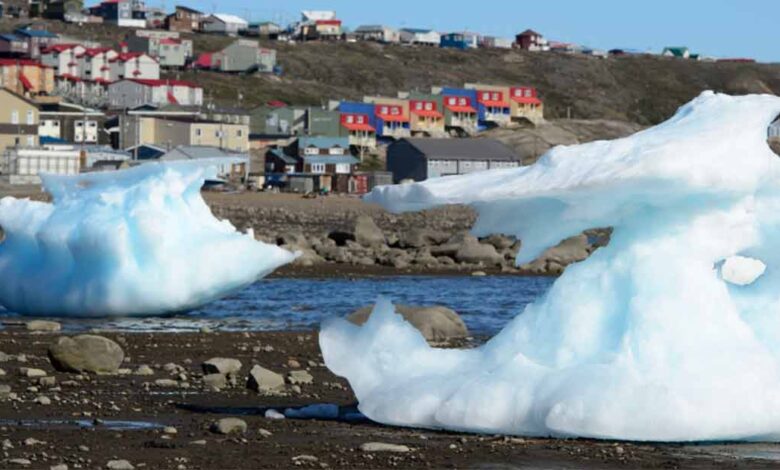
In July, northern communities in Canada are experiencing unprecedented heat, causing concerns for the well-being of residents and wildlife unaccustomed to such high temperatures. Several areas in Yukon and the Northwest Territories are witnessing temperatures higher than ever before, shattering long-standing records.
Environment Canada issued heat warnings on Tuesday for parts of Yukon and N.W.T. with daytime temperatures expected to exceed 29°C. These warnings extend as far north as Inuvik, N.W.T., which is located 200 kilometers beyond the Arctic Circle. These regions typically experience daily temperatures in the low 20s.
Jesse Wagar, a warning preparedness meteorologist at Environment Canada, revealed that four out of the five hottest temperatures ever recorded in the N.W.T. have occurred in the past eight years. Wagar described this situation as a prime example of climate change, emphasizing the alarming rate of warming in the Arctic.
Wagar has observed temperatures in northern communities increasing exponentially over the last decade. In response to rising temperatures in the Arctic, Environment Canada established a new heat threshold specifically for Nunavut. This year marks the first time Nunavut has implemented a heat warning program due to the recognition of heat trends and the astonishing level of temperature increase.
The Northwest Territories has witnessed remarkable temperature records this July. On July 8, Paulatuk, N.W.T., located along the Arctic Ocean, broke its all-time daily maximum temperature record set in 1990 by reaching 29.6°C, surpassing the previous record of 27°C. The Climate Atlas of Canada projects that the area will approach temperatures close to 30°C.
Scientists express deep concern as the heat reaches the northernmost tip of the N.W.T., with other communities in the territory experiencing even higher temperatures. Fort Good Hope, situated on the Mackenzie River, established a new all-time daily maximum temperature of 37.4°C on July 8, breaking the previous record of 35°C set in 1920. Notably, this marks the hottest temperature ever recorded in the northernmost region of Canada. Norman Wells, N.W.T., also broke its all-time daily temperature record on July 8, reaching 37.9°C and surpassing the previous record of 35°C set in 1989.
These records are being shattered by several degrees, unlike the typical marginal increases of 0.1 or 0.2 degrees Celsius. Norman Wells and Fort Good Hope achieved the fourth and fifth hottest days ever documented in the territory, respectively, while the current record holder is Deline, N.W.T., with a record of 39.5°C set in 2015. On July 4, Inuvik broke its all-time daily maximum temperature record set in 2001, reaching 33°C, surpassing the previous record of 32.8°C.
Comparing July 2023 to the previous year, records are being broken at a similar rate, but data from Wagar reveals that May was even hotter. In May, Environment Canada’s internal records indicate that 84 maximum temperature records were broken, compared to only four at the same time in 2022. Wagar predicts high confidence in above-normal temperatures for most of Canada throughout the remainder of the summer, particularly in the northern regions.
In Yukon, Environment Canada issued heat warnings for the Mayo region, including the communities of Carmacks, Faro, and Ross River, where temperatures could reach 30°C. Carmacks broke its all-time daytime high maximum temperature record on July 7, reaching 35.5°C, surpassing the previous record of 35.3°C set in 2004. This makes it the third hottest temperature ever recorded in the territory. Further north, Mayo holds the highest temperature record in Yukon, set in 1969 at 36.1°C. In the last 20 years, three of the top five hottest temperatures in Yukon have occurred.
Yukon has already witnessed 17 high-temperature records broken in the first nine days of July, exceeding the total number of records broken in the entire month of July 2022 by seven. Additionally, in May, Yukon broke 21 new temperature records, according to Environment Canada.
In northwestern Ontario, one record has been broken in July, specifically in Big Trout Lake, which achieved a new daily temperature record of 31.9°C on July 2, surpassing the previous record of 30.8°C set in 2021. In the Nunavik Region of northern Quebec, the community of Kuujjuaq experienced consecutive days in early July with temperatures exceeding 32°C. On July 4, the area broke its all-time daily maximum temperature record, reaching 34.3°C, surpassing the previous record of 33.1°C set in 1999. Thus far, Nunavut has not broken any temperature records this month.
Jesse Wagar emphasizes that extreme heat affects everyone and urges individuals to be vigilant for symptoms of heat illness such as swelling, rash, and cramps. If any of these symptoms arise, it is crucial to take a break from the heat and seek cooler environments.









































